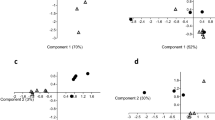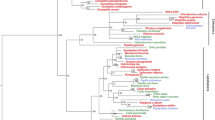Abstract
The host ranges of phytophagous insects are determined to a large degree by plant chemistry. Specialist insects are often closely associated with plants that produce characteristic chemicals, which may act as attractants or stimulants to aid in finding or recognizing a host. Generalist insects are generally believed to rely on the presence of repellents or deterrents to ensure avoidance of unsuitable plants. However, the chemistry of any plant can be highly variable, as a result of growth characteristics, genetic variation, or environmental factors. Such variable chemistry may provide windows of opportunity for nonadapted insects to utilize a plant or for a plant to become resistant to a normally adapted herbivore. Differences in insect responses to plant constituents may also result from genetic variation or environmental factors. In particular, dietary experience has been found to influence the ability of insects to taste plant chemicals that may serve as signals of suitability or unsuitability. Certain dietary constituents appear to suppress the development of taste sensitivity to deterrents in an insect, whereas the presence of specific stimulants in the diet may result in the development of dependence on these compounds. These findings further emphasize the fact that the dynamics of plant biochemistry along with plasticity in the sensory system of insects might be expected to play a major role in the evolution of new plant–insect relationships.
Similar content being viewed by others
REFERENCES
BERNAYS, E. A., and CHAPMAN, R. F. 1994. Host-Plant Selection by Phytophagous Insects. Chapman and Hall, New York.
BROWER, L. P. 1984. Chemical defence in Butterflies. Symp. R. Entomol. Soc. London11:109-134.
CHEW, F. S., and RENWICK, J. A. A. 1995. Host-plant choice in Pierisbutterflies, p. 214-238, inR.T. Cardé and W. J. Bell (eds.). Chemical Ecology of Insects 2. Chapman and Hall, New York.
COURANT, A. V., HOLBROOK, A. E., VAN DER REIJDEN, E. D., and CHEW, F. S. 1994. Native Pierine butterfly (Pieridae) adapting to naturalized crucifer? J. Lepid. Soc.48:168-170.
DAVID, W. A. L., and GARDINER, B. O. C. 1966. Mustard oil glucosides as feeding stimulants for Pieris brassicaelarvae in a semi-synthetic diet. Entomol. Exp. Appl.9:247-255.
DEL CAMPO, M. L. 1999. Behavioral, phytochemical, and developmental aspects of induction of host specificity in the tobacco hornworm to Solanaceae. Doctoral dissertation. Cornell University, Ithaca, New York.
DEL CAMPO, M. L., and RENWICK, J. A. A. 1999. Dependence on host constituents controlling food acceptance by Manduca sextalarvae. Entomol. Exp. Appl.93:209-215.
DEL CAMPO, M. L., and RENWICK, J. A. A. 2000. Induction of host specificity in larvae of Manduca sexta: Chemical dependence controlling host recognition and development rate. Chemoecology10:115-121.
DEL CAMPO, M. L., SCHROEDER, F. C., MILES, C. I., MüLLER, C., BOOKER, R., and RENWICK, J. A. 2001. A host plant compound controls host recognition by the tobacco hornworm: a peripheral neural mechanism for specialization. Nature(in press).
DU, Y.-J., VAN LOON, J. J. A., and RENWICK, J. A. A. 1995. Contact chemoreception of oviposition-stimulating glucosinolates and oviposition-deterrent cardenolides in two subspecies of Pieris napi. Physiol. Entomol.20:164-174.
FELTWELL, J. 1982. The Large White Butterfly: The Biology, Biochemistry, and Physiology of Pieris brassicae(Linnaeus). Dr. W. Junk, Publishers, The Hague.
HARIBAL, M., and RENWICK, J. A. A. 1998. Isovitexin 6''-O-ß-D-Glucopyranoside: A feeding deterrent to Pieris napi oleracaeafrom Alliaria petiolata. Phytochemistry47:1237-1240.
HARIBAL, M., YANG, Z., ATTYGALLE, A. B., RENWICK, J. A. A., and MEINWALD, J. 2001. A cyanoallyl glucoside from Alliaria petiolataas a feeding deterrent for larvae of Pieris napi oleracea. J. Nat. Prod.64:440-443.
HUANG, X. P., and RENWICK, J. A. A. 1994. Relative activities of glucosinolates as oviposition stimulants for Pieris rapaeand P. napi oleracea. J. Chem. Ecol.20:1025-1037.
HUANG, X. P., and RENWICK, J. A. A. 1995a. Chemical and experiential basis for rejection of Tropaeolum majusby Pieris rapaelarvae. J. Chem. Ecol.21:1601-1617.
HUANG, X. P., and RENWICK, J. A. A. 1995b. Cross habituation to feeding deterrents and acceptance of a marginal host plant by Pieris rapaelarvae. Entomol. Exp. Appl.76:295-302.
HUANG, X. P., and RENWICK, J. A. A. 1997. Feeding deterrents and sensitivity suppressors for Pieris rapaelarvae in wheat germ diet. J. Chem. Ecol.23:51-70.
HUANG, X. P., and RENWICK, J. A. A., and SACHDEV-GUPTA, K. 1993. Oviposition stimulants and deterrents regulating differential acceptance of Iberis amaraby Pieris rapaeand P. napi oleracaea. J. Chem. Ecol.19:1645-1663.
HUGENTOBLER, U., and RENWICK, J. A. A. 1995. Effects of plant nutrition on the balance of insect relevant cardenolides and glucosinolates in Erysimum cheiranthoides. Oecologia102:95-101.
HUGHES, P. R. 1974. Myrcene: A precursor of pheromones in Ipsbeetles. J. Insect Physiol.20:1271-1275.
JOHANSSON, A. S. 1951. The food plant preference of the larvae of Pieris brassicaeL. (Lepid., Pieridae). Norsk Entomol. Tidsskr.8:187-195.
MA, W. C. 1972. Dynamics of feeding responses in Pieris brassicaeLinn., as a function of chemosensory input: A behavioral, ultrastructural and electrophysiological study. Meded. Landbouwhoghesch. Wageningen72(11):162 pp.
MILLER, J. R., and STRICKLER, K. L. 1984. Finding and accepting host plants, pp. 127-155, inW. Bell and R. Cardé (eds.). Chemical Ecology of Insects. Chapman and Hall, London.
RENWICK, J. A. A. 1996. Diversity and dynamics of crucifer defenses against adults and larvae of cabbage butterflies, pp. 57-79, inJ.T. Romeo, J.A. Saunders and P. Barbosa (eds.). Recent Advances in Phytochemistry 30. Phytochemiscal Diversity and Redundancy in Ecological interactions. Plenum Press, New York.
RENWICK, J. A. A., and HUANG, X. P. 1994. Interacting chemical stimuli mediating oviposition by Lepidoptera, pp. 79-94, inT.N. Ananthakrishnan (ed.). Functional Dynamics of Phytophagous Insects. Oxford & IBH Publishing, New Delhi.
RENWICK, J. A. A., and HUANG, X. P. 1995. Rejection of host plant by larvae of cabbage butterfly: Diet-dependent sensitivity to an antifeedant. J. Chem. Ecol.21:465-475.
RENWICK, J. A. A., and LOPEZ, K. 1999. Experience-based food consumption by larvae of Pieris rapae: Addiction to glucosinolates? Entomol. Exp. Appl.91:51-58.
RENWICK, J. A. A., RADKE, C. D., SACHDEV-GUPTA, K., and STäDLER, E. 1992. Leaf surface chemicals stimulating oviposition by Pieris rapae(Lepidoptera: Pieridae) on cabbage. Chemoecology3:33-38.
ROWELL-RAHIER, M., and PASTEELS, J. M. 1993. Third trophic level influences of plant allelochemicals, pp. 243-277, inG.A. Rosenthal and M.R. Berenbaum (eds.). Herbivores: Their Interactions with Secondary Plant Metabolites II. Ecological and Evolutionary Processes. Academic Press, San Diego.
SACHDEV-GUPTA, K., RENWICK, J. A. A., and RADKE, C. D. 1990. Isolation and identification of oviposition deterrents to cabbage butterfly, Pieris rapae, from Erysimum cheiranthoides. J. Chem. Ecol.16:1059-1067.
SCHOONHOVEN, L. M. 1987. What makes a caterpillar eat? The sensory code underlying feeding behavior, pp. 69-97, inR.F. Chapman, E.A. Bernays and J.G. Stoffolano (eds.). Advances in Chemoreception and Behavior. Springer-Verlag, New York.
SCHOONHOVEN, L. M., JERMY, T., and VAN LOON, J. J. A. 1998. Insect-Plant Biology. From Physiology to Evolution. Chapman & Hall, London.
STäDLER, E., and HANSON, F. E. 1978. Food discrimination and induction of preference for artificial diets in the tobacco hornworm, Manduca sexta. Physiol. Entomol.3:121-133.
STäDLER, E., RENWICK, J. A. A., RADKE, C. D., and SACHDEV-GUPTA, K. 1995. Tarsal contact chemoreceptor response to glucosinolates and cardenolides mediating oviposition in Pieris rapae. Physiol. Entomol.20:175-187.
SZENTESI, A., and JERMY, T. 1989. The role of experience in host plant choice by phytophagous insects, pp. 39-74, inE.A. Bernays (ed.). Insect-Plant Interactions, Vol. II. CRC Press, Boca Raton, Florida.
THORSTEINSON, A. J. 1953. The chemotactic responses that determine host specificity in an oligophagous insect [Plutella maculipennis. (Curt.) Lepidoptera]. Can. J. Zool.31:53-72.
VAN LOON, J. J. A., and SCHOONHOVEN, L. M. 1999. Specialist deterrent chemoreceptors enable Pieriscaterpillars to discriminate between chemically different deterrents. Entomol. Exp. Appl.91:29-35.
VERSCHAFFELT, E. 1910. The cause determining the selection of food in some herbivorous insects. Proc. K. Ned. Akad. Wet.13:536-542.
Author information
Authors and Affiliations
Rights and permissions
About this article
Cite this article
Renwick, J.A.A. Variable Diets and Changing Taste in Plant–Insect Relationships. J Chem Ecol 27, 1063–1076 (2001). https://doi.org/10.1023/A:1010381509601
Issue Date:
DOI: https://doi.org/10.1023/A:1010381509601




